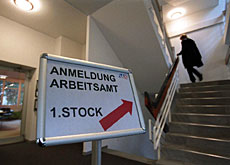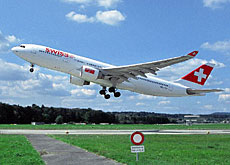Recovery fails to check rising unemployment

Unemployment in Switzerland is continuing to rise, with the jobless rate hitting 4.3 per cent last month - its highest level for six years.
However, the economics ministry said it drew some signs of encouragement from the January figures, which fell for the third year in succession.
In a statement released on Monday, the State Secretariat for Economic Affairs (Seco) said the number of people registered out of work rose by over 5,000 to 168,163 in January.
The jobless rate was up 0.2 of a percentage point on December’s figure. However, taking into account seasonal hiring, the rate was unchanged at 3.9 per cent.
Jean-Luc Nordmann, head of Seco’s labour division, put a positive spin on January’s figures, insisting they were not as bad as they seemed.
He said the jobless increase was almost half that of a year ago when a rise of more than 9,000 was recorded. Nordmann added that this was the third time in a row that the figures for January had fallen.
In addition, there was the significant rise in job vacancies – up from 3,408 to 9,451 – which analysts said was a promising sign.
But some experts warned that although the seasonally-adjusted rate signalled that the job market – hit by large-scale lay-offs in the past few years – was stabilising, uncertainties remained about the economic recovery.
Seasonal effect
The unemployment figures for January are traditionally higher due to the so-called seasonal effect. In certain industries, such as the building, paper and wood, there is normally less demand for workers during the winter.
For this reason, unemployment in the building trade rose to 14.7 per cent in January and stood at around ten per cent in other affected sectors.
Analysts said that employers were shying away from hiring due to concerns about the economy.
Unemployment also varied across the “Röstigraben” – the imaginary divide between the two main language regions, French and German.
The French-speaking part was worst affected by unemployment, with a seven per cent rate being recorded in Geneva. The jobless rate in Zurich and Basel in the German-speaking part of the country stood at five per cent.
Nordmann said he expected the seasonal effect to persist until March when there should be a small decrease.
Last week the economics ministry revised upwards its forecast for economic growth in 2004.
It now expects Gross Domestic Product to rise by 1.8 per cent, up 0.3 of a percentage point from October’s forecast.
The ministry also predicted that the unemployment rate would fall to an average 3.7 per cent by the end of the year.
swissinfo with agencies
January’s unemployment rate rose to 4.3 per cent – the highest rate for almost six years.
Number of unemployed rose by over 5,000 to 168,163 in January
But there was a smaller increase in the number of unemployed compared to the same period last year.
The number of available jobs rose from 3,408 to 9,451.

In compliance with the JTI standards
More: SWI swissinfo.ch certified by the Journalism Trust Initiative











You can find an overview of ongoing debates with our journalists here . Please join us!
If you want to start a conversation about a topic raised in this article or want to report factual errors, email us at english@swissinfo.ch.